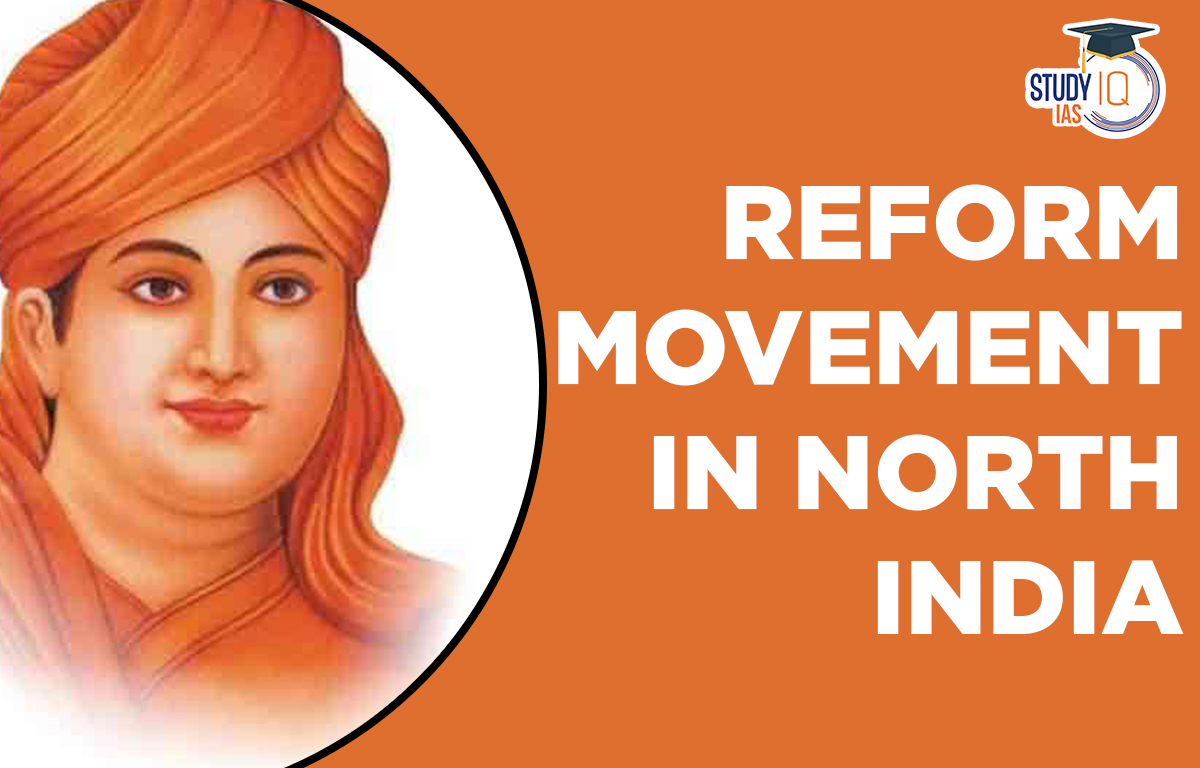Table of Contents
Reform Movement in North India
Swami Dayanand Saraswati (1824–1833) led the Reform Movement in North India and established the Arya Samaj in 1875. This society worked to eradicate the caste system, rituals, priesthood, idolatry, polytheism, and animal sacrifice. Reform movement in North India is one of the important topics of Modern History; this article has all the details related to Reform Movement in North India for the candidates preparing for UPSC Examination.
Read More: Reform Movements in Southern India
Reform Movement in North India History
Swamy Dayanand Saraswati, who established the Arya Samaj in 1875, was the driving force behind the social and religious change in North India. Swamy denounced superstitious customs, polytheism, Brahmin-sponsored religious rites, and idolatry. He supported adult marriages, intercaste unions, and the education of women. His teachings took on an orthodox flavour as a result of his inclination towards the Vedas, which he held infallible.
In North India, the Arya Samajists advanced the cause of social change in a progressive manner. They campaigned for social equality, improved the lot of women, and opposed caste discrimination and untouchability. Despite the veneration of the Vedas as infallible, the reforms ad vacated were the result of contemporary logical thought.
Read More: Young Bengal Movement
Arya Samaj
The Arya Samaj took on the mission of reforming Hinduism in north and western India. In 1875, Swami Dayanand Saraswati founded it (1824-83). Swami Dayanand thought that the Puranas, which he claimed were replete with false doctrine, had helped ignorant and self-centered priests corrupt Hinduism. Swami Dayanand looked to the Vedas, which he regarded as infallible since they were the inspired word of God and the source of all knowledge, for inspiration.
Later, a few of Swami Dayanand’s adherents established a network of schools and universities around the nation to provide education along western lines. Lala Hansraj was instrumental in this endeavour. Swami Shradhananda established the Gurukul close to Hardwar in 1902 in order to advance the more conventional educational objectives. Preventing Hindus from converting to other religions was one of Arya Samaj’s goals. It launched a battle against other religions as a result of this. This crusade played a role in the development of communalism in India during the 20th century.
Read More: Ramakrishna Mission
Shuddhi Movement
Swami Dayanand Saraswati, the Arya Samaj’s founder, began the Shuddhi movement in the early 20th century. There were essentially two objectives in play for this sociopolitical movement. One goal was to convert Hindus who had left Hinduism for any reason to become Muslims or Christians, and the other was to protect people from untouchability’s harmful customs and prevent them from becoming outcasts of their own religion.
Read More: Temple Entry Movement
Shuddhi Movement Objective
The movement criticised Christian missionaries for converting poor, unhappy, and illiterate Hindus to Christianity in order to further their own agendas. Due to Swami’s boldness and character, more than 18000 Muslims in the state of Uttar Pradesh alone returned to Hinduism.
Swami Shraddhanand established the Bhartiya Hindu Shuddhi Mahasabha in 1923 and promoted the idea of reconversion, which sparked conflict between the two sects in the end. In 1877, the first Muslim conversion was officially documented. Muslim advocates perceived this movement as a serious threat, and they definitely did not react well to it. They asked the Muslim community for assistance in an effort to entice them back to the Muslim community. A Muslim fanatic killed Swami Dayanand Saraswati in December of 1926.
Read More: Reform Movements by Parsi
Dev Samaj
Shiv Narayan Agnihotri (1850–1927), a former Brahmo adherent, founded the Dev Samaj in 1887 in Lahore. Dev Sadan is a religious and social reform organisation. The community placed a strong stress on the soul’s eternities, the guru’s supremacy, and the necessity of moral behaviour. The ideal social behaviour it demanded was to refrain from accepting bribes, abstain from alcohol and meat, and refrain from using violence. The Deva Shastra is a book that contains all of its teachings. Child marriage was condemned by Agnihotri.
Read More: Akali Movement
Dev Samaj Objective
The Dev Samaj was originally a theistic community, but it later reemerged as a movement dedicated to social reform, demanding stringent moral behavior from its adherents and supporting, among other things, caste integration and women’s education. Although it denied the existence of traditional gods, it highlighted Agnihotri’s semidivinity, claiming that without his guidance it was impossible to reach eternal joy and that he had gained the greatest possible degree of existence.
Read More: Aligarh Movement
Reform Movement in North India UPSC
Swami Dayanand Saraswati (1824–1833), who established the Arya Samaj in 1875, was the driving force behind the social and religious change in North India. This society worked to eradicate the caste system, rituals, priesthood, idolatry, polytheism, and animal sacrifice. Read the article for all the information related to Reform Movement in North India for UPSC Exam Preparations.
Read More: Faraizi Movement


 El Nino and La Nina and its Impact on In...
El Nino and La Nina and its Impact on In...
 Manganese Ore, Uses, Properties, Importa...
Manganese Ore, Uses, Properties, Importa...
 Faraizi Movement, History, Founder, Begi...
Faraizi Movement, History, Founder, Begi...




















